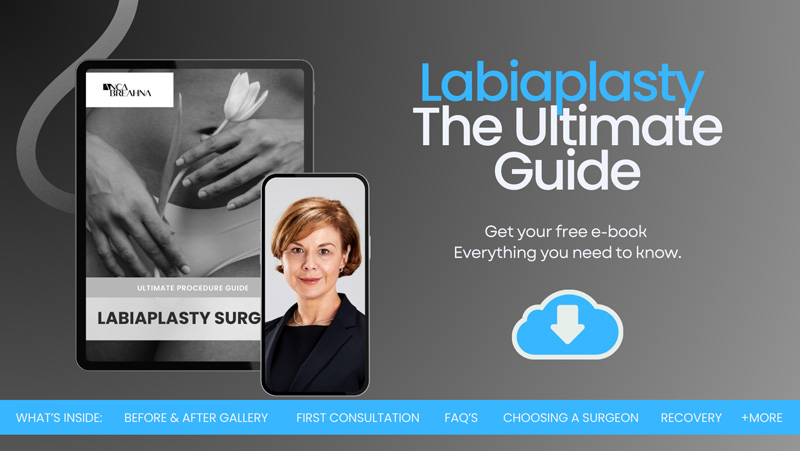
Table of Contents
- How Are the Scars after Labiaplasty Surgery?
- Download Anca Breahna’s Labiaplasty Guide
- What Are Labiaplasty Scars?
- Factors Influencing Labiaplasty Scars
- Techniques to Minimise Labiaplasty Scars
- Surgical Techniques to Reduce Scarring
- Post-Operative Care to Minimise Scarring
- Post-Operative Care to Reduce Labiaplasty Scars
- Techniques for Optimal Recovery from Labiaplasty
- Myths and Facts about Labiaplasty Scars
- Seeking Professional Help to Reduce Labiaplasty Scars
- Laser Therapy to Reduce Labiaplasty Scars
- FAQs about Scars after Labiaplasty
- Further Reading about Procedures at Cheshire Cosmetic Surgery
How Are the Scars after Labiaplasty Surgery?
Labiaplasty is a surgical procedure that is becoming increasingly popular among women worldwide. It is a personal decision that involves the reshaping or resizing of the labia minora or majora, the outer folds of skin surrounding the human vulva. Despite the increasing demand and progressive techniques, one concern that remains prevalent is the potential for labiaplasty scars.
The surgical process, like any other, carries the risk of leaving behind a physical reminder in the form of scarring. It’s essential to note that the degree of scarring varies due to numerous factors. The good news is that there are ways to minimise the visibility and impact of these scars.
In this blog, Chester Consultant Plastic Surgeon Anca Breahna will discuss the factors that influence labiaplasty scars, techniques to reduce them, and recommendations for optimal recovery from the procedure. You’ll also discover some of the common myths surrounding labiaplasty scars and how professional help can aid in reducing them effectively.
Download Anca Breahna’s Labiaplasty Guide

What Are Labiaplasty Scars?
Labiaplasty scars are the marks left on the labia after the surgical procedure. These are typically located along the edges of the labia where the incisions were made. Depending on the surgical technique used and your body’s healing process, these scars can be more or less noticeable.
It’s important to note that everyone’s body reacts differently to surgery. That means the appearance of your labiaplasty scars can vary greatly from someone else’s. Some people may have faint, barely noticeable scars, while others might have more prominent ones.
The key to reducing the visibility of these scars is understanding the factors that influence them and taking steps to minimise their impact.
Factors Influencing Labiaplasty Scars
Several factors can influence the appearance and severity of labiaplasty scars. These include the surgical technique used, your body’s natural healing process, your overall health and lifestyle, and the care you take post-operation.
The surgical technique plays a significant role in determining the type and extent of the scars. For instance, the ‘trim’ technique, which involves cutting excess tissue and stitching the edge, generally results in a more noticeable scar compared to the ‘wedge’ technique, where a V-shaped piece of tissue is removed and the edges are sutured together, resulting in a less noticeable scar.
Your body’s natural healing ability also influences the appearance of the scars. Some people naturally heal with minimal scarring, while others may develop hypertrophic or keloid scars, which are raised and more visible. Your overall health and lifestyle, including your diet, smoking habits, and exposure to sunlight, can also impact your body’s healing process and the appearance of the scars.
Techniques to Minimise Labiaplasty Scars
Surgical Techniques to Reduce Scarring
- Choice of Surgical Technique: The method chosen by the plastic surgeon plays a crucial role in the extent of scarring. The wedge technique, for instance, involves removing a pie-shaped piece of tissue and rejoining the edges. This method generally results in less noticeable scarring compared to the trim technique, where the excess edge of the labia minora is trimmed straight across. The wedge technique allows for scars to be hidden within the natural folds of the labia, making them less visible
- Use of Absorbable Sutures: The type of sutures used can also impact scarring. Absorbable sutures, which dissolve over time, are often preferred in labiaplasty. These sutures negate the need for removal, reducing the risk of additional trauma or scarring to the area. Additionally, they tend to cause less irritation during the healing process, which can further minimise scar formation
- Precise Incision and Suturing Techniques: The skill and precision of the surgeon are paramount. Fine, meticulous suturing can significantly reduce the appearance of scars. Surgeons who specialise in labiaplasty often use advanced techniques to ensure that incisions are as minimal and discreet as possible
Post-Operative Care to Minimise Scarring
- Maintaining Cleanliness: Keeping the surgical area clean is essential for preventing infection, which can worsen scarring. Gentle cleansing as per the surgeon’s instructions helps in maintaining hygiene without irritating the incisions
- Topical Scar Reduction Treatments: After the initial healing phase, the application of scar reduction creams or gels, particularly those containing silicone, can be beneficial. These products help in hydrating the scar and can reduce scar thickness and discolouration. They should be used as directed by Anca for optimal results
- Avoiding Strain on the Area: It’s crucial to avoid activities that could put strain on the healing tissues. This includes avoiding certain exercises, sexual activities, or wearing tight clothing that might rub against the incisions. Giving the body ample time to heal without additional stress is key to minimising scar formation
- Sun Protection: Protecting the area from sun exposure is important as UV rays can darken scars, making them more noticeable. Using a physical barrier or a gentle, non-irritating sunscreen specifically designed for sensitive areas can be helpful once the initial healing has occurred
- Proper Nutrition and Hydration: Good nutrition plays a role in the body’s healing process. A diet rich in vitamins and minerals, particularly those that aid in skin healing like Vitamin C and zinc, can promote better healing and potentially reduce scarring. Staying well-hydrated also supports skin health and healing
- Follow-up Care: Regular follow-up appointments with Anca are important to monitor the healing process. The surgeon can provide personalised advice and, if necessary, recommend additional treatments like laser therapy or microneedling, which can further improve the appearance of scars
- Gentle Massage: Once the area has sufficiently healed and with Anca’s approval, gentle massage of the scarred area can improve blood flow and help in breaking down scar tissue, making the scars softer and less noticeable
Post-Operative Care to Reduce Labiaplasty Scars
Post-operative care is essential in minimising labiaplasty scars. One of the first steps is ensuring the surgical area remains clean and free from infection. You should follow all of Anca’s instructions regarding cleaning and care, and report any signs of infection, such as increased redness, swelling, or pain.
Applying topical scar reduction creams can also be beneficial. These products often contain ingredients like silicone, which has been shown to help reduce the formation of hypertrophic and keloid scars. However, you should always discuss the use of these products with Anca before starting them.
It’s also important to avoid activities that could strain the area and disrupt the healing process. This includes vigorous exercise, sexual activity, and wearing tight clothing. By giving the area time to heal and avoiding potential sources of irritation, you can help ensure your scars are as minimal as possible.
Techniques for Optimal Recovery from Labiaplasty
Anca often recommends a combination of treatments to enhance the healing process and reduce the appearance of labiaplasty scars. This may include the use of cold compresses to reduce swelling, wearing loose clothing to avoid irritation, and maintaining a healthy lifestyle to support your body’s natural healing process.
Additionally, Anca may recommend specific exercises to improve blood flow to the area, speeding up the healing process and reducing the risk of noticeable scars. She may also suggest the use of vitamin E oil, which can help soften scars and improve their appearance.
It’s important to remember that although these techniques can help, they can’t completely eliminate labiaplasty scars. What they can do is help make the scars less noticeable and reduce any associated discomfort or other symptoms.
Myths and Facts about Labiaplasty Scars
There are many myths surrounding labiaplasty scars, which can lead to unnecessary worry or misunderstanding. Here, we’ll debunk some of these myths and provide you with the facts.
One common myth is that labiaplasty always results in noticeable scars. The truth is, the visibility of labiaplasty scars largely depends on individual healing factors and the surgical technique used. While some people may have more noticeable scars, others may have scars that are hardly visible.
Another myth is that labiaplasty scars can cause significant discomfort or pain. While there can be some discomfort during the healing process, this usually subsides as the area heals. Persistent pain is not common and should be addressed with your plastic surgeon.
Seeking Professional Help to Reduce Labiaplasty Scars
If you’re concerned about your labiaplasty scars, it’s advisable to seek professional help. A skilled and experienced plastic surgeon can provide you with advice and treatment options to reduce the appearance of your scars. This might involve recommending specific scar reduction products or treatments like laser therapy.
Additionally, a professional can provide reassurance and help you set realistic expectations about your scars. Keep in mind that it’s normal to have some degree of scarring after a surgical procedure, and a professional can help you understand what to expect.
Laser Therapy to Reduce Labiaplasty Scars
One of the most effective treatments for reducing labiaplasty scars is laser therapy. Laser therapy involves using concentrated light beams to stimulate the body’s natural healing processes and reduce the appearance of scars.
Laser therapy can be used to reduce the redness and thickness of scars, making them less noticeable. It can also help improve the texture of the skin and reduce any discomfort associated with the scars.
Keep in mind that laser therapy should only be performed by a trained professional. If you’re considering this treatment, it’s important to discuss it with Anca to understand the potential risks and benefits.
While labiaplasty can result in scars, there are many strategies and treatments available to minimise their appearance. By understanding the factors that influence scarring and taking steps to support your body’s healing process, you can help ensure your scars are as minimal as possible.
FAQs about Scars after Labiaplasty

What type of scarring can I expect after labiaplasty?
Post-labiaplasty scarring varies depending on individual healing processes and the surgical technique used. Generally, scars are minimal and strategically placed to be less noticeable. They appear as fine lines that fade over time. The labial skin has a remarkable ability to heal, and with proper care, scars often become barely visible within a year. It’s important to follow Anca’s post-operative instructions, including wound care and avoiding strenuous activities, to ensure optimal healing and minimal scarring.
How long does it take for scars to heal completely after labiaplasty?
The healing process for scars after labiaplasty can take several months to a year. Initially, scars may appear red and slightly raised, but they gradually fade and flatten. The first few months are crucial for scar maturation. Factors like your overall health, nutrition, and smoking habits can also impact the healing process. Regular follow-ups with your plastic surgeon can help monitor the healing and address any concerns.
Are there any treatments to minimise scarring after labiaplasty?
Yes, there are several treatments and practices to minimise scarring after labiaplasty. Silicone gel sheets or scar creams, particularly those containing silicone, are often recommended as they can help in scar flattening and lightening. Gentle massage of the scar area, once healed, can also improve the appearance by increasing blood flow. In some cases, laser treatments may be suggested by Anca for further scar improvement.
Will scars from labiaplasty affect sensation or function?
Scars from labiaplasty typically do not affect sensation or function. The goal of labiaplasty is to improve comfort and aesthetics without compromising sensitivity or sexual function. In most cases, patients report no change or even an improvement in sensation due to the removal of excess, uncomfortable tissue. However, as with any surgery, there are risks involved. Discussing these concerns with Anca before the procedure can provide a clearer understanding of the potential outcomes.
Can scars from labiaplasty be completely invisible?
While labiaplasty scars can become extremely subtle and barely noticeable, they may not be completely invisible. The visibility of scars depends on several factors, including your skin type, the surgical technique used, and how your body heals. Most scars fade significantly over time and are placed in less conspicuous areas to ensure they are as discreet as possible. Your surgeon’s expertise in performing the procedure also plays a crucial role in minimising scar visibility.
Medical References about Labiaplasty
- Labiaplasty: Surgery, Recovery & What To Expect – Cleveland Clinic
- Labiaplasty | Aesthetic Genital Plastic Surgery – American Society of Plastic Surgeons
- Long-Term Follow-up in Labiaplasty in 414 Women
- Motivations, Expectations, and Experiences of Labiaplasty
- A Retrospective Study of the Psychological Outcomes of Labiaplasty
Further Reading about Procedures at Cheshire Cosmetic Surgery
- Read more about Labiaplasty
- Read more about Desirial Injections (Vaginal Dryness)
- Read more about Recovery after Labiaplasty
- Read more about What Are the Trim and Wedge Methods for Labiaplasty Surgery?
- Read more about Exercise after Labiaplasty
- Read more about Labiaplasty Types – Trim Labiaplasty and Wedge Labiaplasty or Hybrid
- Read more about 10 Questions to Ask Your Surgeon before Labiaplasty Surgery







